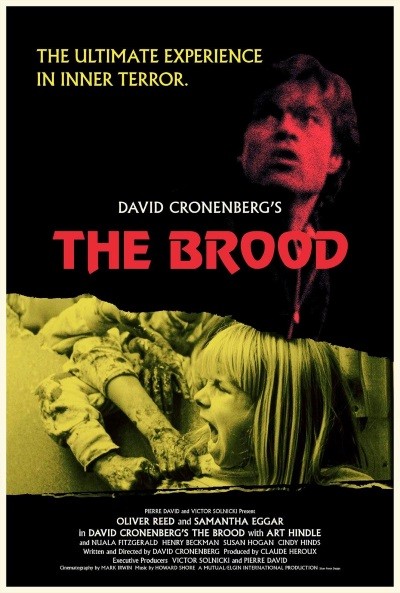 The horror movie inverse of KRAMER VS. KRAMER? That’s been a frequent description of David Cronenberg’s THE BROOD (1979), the wildest film to emerge from the late 20th Century divorce movie craze (which includes the aforementioned KRAMER VS. KRAMER, along with ORDINARY PEOPLE, SHOOT THE MOON, SMASH PALACE and MY FIRST WIFE). The addition of the Canadian made BROOD to that group isn’t as perverse as it might seem, as like those films it deals with an especially unpleasant divorce and was at least partially autobiographical on the part of its writer-director, who based it on his own divorce and subsequent custody battle.
The horror movie inverse of KRAMER VS. KRAMER? That’s been a frequent description of David Cronenberg’s THE BROOD (1979), the wildest film to emerge from the late 20th Century divorce movie craze (which includes the aforementioned KRAMER VS. KRAMER, along with ORDINARY PEOPLE, SHOOT THE MOON, SMASH PALACE and MY FIRST WIFE). The addition of the Canadian made BROOD to that group isn’t as perverse as it might seem, as like those films it deals with an especially unpleasant divorce and was at least partially autobiographical on the part of its writer-director, who based it on his own divorce and subsequent custody battle.
THE BROOD was also the subject of an especially interesting 2020 book — a “forensic and holistic” study by Stephen Bissette, who vastly overrates the film (admittedly because it has a personal resonance, which he details at great length in a book that functions as both autobiography and analysis). He’s not alone, as many Cronenberg commentators insist on over-praising the film shamelessly, due more to its pedigree—it’s viewed as Cronenberg’s major transitional film, bridging the grade-B horror of SHIVERS and RABID with the statelier likes of DEAD RINGERS and CRASH—than any real qualities it might possess. Cronenberg himself reportedly considers THE BROOD his “most personal” film, which may explain why he refrained from any direct involvement with the Bissette book or 2015 Criterion Blu-ray.
The film begins with Dr. Hal Raglan, the world’s meanest psychiatrist, informing a male patient that he’s “weak” and might as well be a woman. Dr. Raglan is obsessed with the concept of externalizing psychic disturbances, having published a book (entitled THE SHAPE OF RAGE) on the subject and set up a secluded clinic in which his patients are locked up.
Among those patients is Nola Carter, a man-hating nymphomaniac who’s just gotten divorced from the more stable Frank. The latter has won custody of their young daughter Candice, driving Nola (quite literally) into the arms of the not-so-good doctor, who considers her his star patient. She also, based on bruises Frank finds on Candy’s back, appears to be abusing Candy during her weekend visits.
After about twenty minutes the first of the film’s gory set-pieces is unveiled, involving a pair of dimly glimpsed child-like critters who beat Candy’s grandmother to death with kitchen mallets (old lady bashing being a favorite early Cronenberg device—think back to the codgers menaced by parasites in SHIVERS and the coot getting psychically attacked in SCANNERS). Next they go after another elderly relative, who they once again bludgeon to death. Frank, however, manages to capture one of things, and take him back to the police station; there it’s examined and proclaimed an orphaned child, abandoned most likely due to its physical deformities, which include the absence of a belly button.
But the child-things aren’t yet done, as Frank’s schoolteacher girlfriend gets walloped by them in the middle of her grade school class. The things then kidnap Candy from the class and, in the film’s second most striking image (the first is mentioned below), lead her by the hands down a snowy road to Raglan’s secluded cabin, where Nola happens to be. Frank also heads to the cabin, where he learns the truth: the creatures are physical manifestations of Nola’s inner rage, destroying anyone she feels threatened by; how precisely these creatures are birthed is depicted quite graphically in the climax, which is undoubtedly the film’s most striking scene.
Cronenberg’s screenwriting skills don’t generally get much credit, but they’re quite evident here. The BROOD script is ingenious in its use of misdirection, particularly in the depiction of freakish child-like creatures who are mistaken, quite credibly, for deformed kids on a killing spree. The scene depicting the critters’ origin, to which the entire film carefully builds up, is a climax that for once delivers everything it promises, being genuinely shocking, unexpected and grotesque.
Unfortunately Cronenberg’s filmmaking hadn’t yet caught up with the excellence of his writing. That’s evident in his overuse of Howard Shore’s twangy string-heavy score and overreliance on shock effects that (the climax aside) aren’t very shocking.
The wildly uneven performances are another liability. Oliver Reed is fairly strong as Dr. Raglan but Samantha Eggar is far too one-note as Nola (reflecting the shallow misogyny of a rather ill-conceived role), while the performances of Art Hindle as Frank and Susan Hogan as his girlfriend are plain lousy. The young Cindy Hinds, on the other hand, is quite moving as Candy, whose severely traumatized air is never less than horrifically convincing.
Vital Statistics
THE BROOD
Montreal Trust Company of Canada
Director: David Cronenberg
Producer: Claude Heroux
Screenplay: David Cronenberg
Cinematography: Mark Irwin
Editing: Alan Collins
Cast: Oliver Reed, Samantha Eggar, Art Hindle, Henry Beckman, Nuala Fitzgerald, Cindy Hinds, Susan Hogan, Gary McKeehan, Michael Magee, Robert A. Silverman, Joseph Shaw, Larry Solway, Reiner Schwarz, Felix Silla
